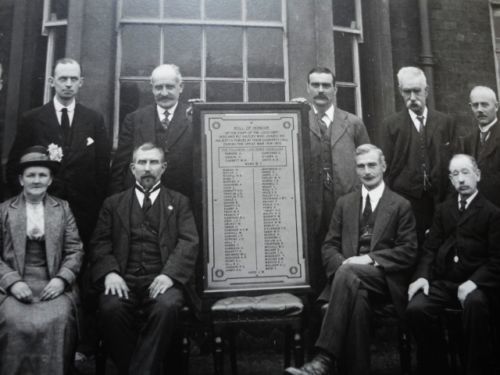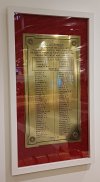It’s stated very clearly on the memorial that that’s what it means. Quite unusual - but by no means unique. Possibly more common where you have a company (or some other “restricted pool”) wishing to honour all who joined up. Cynically “look how patriotic we were” compared with Bloggs and Son down the road.
Indeed by no means unique - I have seen war memorials in village churches (often when the memorial is a scroll or similar
inside the church) where everyone who served from the parish / village is listed and those who died are separately identified - perhaps by a cross next to their name for example - will often have a 'key' on it somewhere that says that the cross indicates for example 'laid down their life' or some form of words, but all villagers who served are listed.
Public stone memorials however more commonly only name those who lost their lives I suspect. Total speculation on my part here but that
may be because of issues like the size of a stone memorial, or the number of names to be carved on it - all of which would have had cost implications at the time, might have served to result in only those whose lives were lost getting listed on such a stone memorial. This cost matter would not be such an issue on a paper scroll or wooden inscribed tablet I speculate.
The War Memorials Trust has a number of interesting fact sheet type resources on memorials and this sort of thing may get addressed in one of those.
As an aside there was a lot of controversy at the time of WW1 about things like this, with some resistance to the idea that memorials should treat all of the dead equally - which resulted in the CWGC (then IWGC) gravestones being all the same style / size etc. Essentially this was because some people (those with the wealth to do so presumably) wanted to erect 'grander' graves / tombstones and or wanted to pay to repatriate the bodies of their family members, and this was resisted by the committee set up to address the issue of large numbers of those being killed and how to mark their graves, and also indeed the names of the missing. See online information about Sir Fabian Ware if interested in this.
 I have contacted the person who posted it but he can't remember where he found it. Possibly from a magazine? It seems to be cropped from a larger photo. Any help would be much appreciated. Thank you.
I have contacted the person who posted it but he can't remember where he found it. Possibly from a magazine? It seems to be cropped from a larger photo. Any help would be much appreciated. Thank you.

